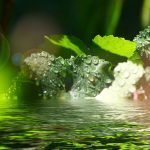Nature Cure Clinical Pearls
Sussanna Czeranko, ND, BBE
Exercise should be strongly insisted; none of the means of preserving the health of pregnant women is more valuable than this. – Dr Hester Pendleton, 1851, p.177
Many delicate ladies have said to me that they would die before they would submit to examinations needful to their cure by a male physician. – Dr Mary S. Gove Nichols, 1851, p.17
I will merely add, and with deference that I have in this city [New York City], as many know, practiced the water treatment in a very considerable number of cases of midwifery, and I affirm, that no case can be found in which we have had any serious difficulty, or in which we have not had most remarkable success. – Dr Joel Shew, 1856, p.165
Hydrotherapy establishments flourished in America in the early 19th century. They offered safe options for those unable to afford expensive and sometimes dangerous medical treatments, which all too often defaulted to drugs and surgical interventions. The proliferation of “water cure” facilities aligned with the growth in Vincent Priessnitz’s influence upon North American doctors who had journeyed in large numbers to Gräefenberg to study his water healing methods. Returning home, these inspired (and transformed) doctors quickly set about establishing many new water healing centers. Not only did they use the water therapies they learned about under the tutorship of Priessnitz, these men and women also wrote about their cases and began to document their observations and experiences.
Reading their literature, we quickly discover their deep understanding of hydrotherapy. Their contributions are priceless, although, sadly, they have disappeared with so many of the books of that era. Even so, there are pearls to be rediscovered, such as one collection, a 7-volume series called Water-Cure Library, published in the mid-19th century. It featured several hydropathic physicians, both men and women, who left behind accounts of their efforts to heal patients without resorting to the standard of care in their day, such as mercury, bloodletting, and toxic cocktails of drugs. Their case reports are stunning, even miraculous, in their heroic achievements with the simple use of healthy dietary recommendations, physical exercise, and hydrotherapy.
Fifty years before the advent and rapid waxing of the new naturopathic healing paradigm and lexicon (which re-embraced hydrotherapy), there had actually been an earlier, first wave of hydrotherapy in America. It occurred in the early part of the 19th century, although water cure itself waned a few decades later. Even so, it was a golden era of hydrotherapy. In 1900, the first spark of Naturopathy surfaced, albeit long after the passing of many of these heroic water physicians. The more I read about Vincent Priessnitz and the men and women who followed in his footsteps, the more resolved I become to keep exploring these lost therapeutic treasures which lie buried in the mid-19th century hydrotherapy literature. That literature is rich with clinical pearls, as well as valuable didactic and theoretical information and data. In so many areas of serious health concern, hydrotherapy was hugely effective.
Complications of Pregnancy
Let us revisit childbirth and pregnancy-related issues, as a case in point in that effectiveness. Pregnancy in the mid-19th century was fraught with many complications that are not unfamiliar to women today. Over these last 170 years, many childbirth issues have persisted; in fact, our ability to deal with unnecessary symptoms during pregnancy – without the radical medicalizing of birth or heroic drug intervention – seems challenged even today. In this regard, last month we looked at how cold-water hydrotherapies came to the aid of women when they were giving birth. Let’s examine the options available for women when faced with unexpected complications arising during pregnancy and delivery. We will review common conditions experienced by these women, such as morning sickness, constipation and hemorrhoids, insomnia, and puerperal fever.
Morning Sickness
In the 19th century, women who suffered from nausea and vomiting were also those female patients most likely to be physically inactive, who drank tea and coffee, and who subsisted on refined foods – habits which naturopathic doctors knew caused indigestion and led to constipation. These confounding factors sadly continue as contemporary catalysts for morning sickness, except that we can now add to this list environmental toxic burden, EMF, junk food and several thousand food additives, and a devastating sedentary lifestyle.
Dr Joel Shew was writing about such issues as far back as 1851. He writes that he found that women “who have good constitutions, and [who] live consistently, [that is] practicing daily bathing and water drinking [were] troubled but very little with these symptoms.” (Shew, 1851, vol. 7, p.70) His dietary advice consisted of eating smaller quantities, chewing well, and eschewing all stimulating drinks, such as coffee and tea. If vomiting did occur, he noted, drinking large quantities of lukewarm water helped to thoroughly clean the stomach. Shew adds, “People often err in these cases of excessive vomiting, by taking too much food at a time.” (Shew, 1851, vol. 7, p.72) A case of vomiting is presented later in this article with a comprehensive treatment plan that is very applicable for women today.
Constipation
Shew’s observations about the causes of constipation are familiar to us over a century and a half later. He writes, “American people have such a predilection for fine food, it is hard matter to make any great change in this respect.” (Shew, 1851, vol. 7, p.76) Shew blamed “super fine flour … as the greatest of all causes of constipation.” (Shew, 1851, vol. 7, p.76) Tea and coffee and their astringent properties were also contributing factors, not to mention sedentary lifestyles. One concludes that our lifestyle habits have changed little in those 170 years.
Mary Nichols, another healer of that era, notes that too much haste in eating was the culprit. She writes: “The great trouble with Americans, is, they are in too great a hurry. They are in a hurry to eat and drink and to get rich. They get sick as fast as they can, and they want a short cut to health.” (Nichols, 1851, p.12)
Constipation, in any case, was responsible for many of the other symptoms associated with pregnancy, such as nausea, vomiting, headaches, heartburn, heart palpitations, fainting and insomnia. (Shew, 1851, vol. 7, p.76) If constipation was not solely responsible for causing other symptoms, it certainly aggravated these symptoms.
The cure for constipation, in general, was the same cure for pregnant women suffering from the same issue. Eating a diet of “brown bread, fruits and vegetables, with a very moderate use of milk; regular exercise, the hip bath, wet girdle, [enemas] of cold water, or tepid if preferred, are the means to be used.” (Shew, 1851, vol. 7, p.77)
Piles and Hemorrhoids
Piles, another consequence of constipation, could also be aggravated by insufficient physical exercise or by the opposite extreme of excessive standing or too much exercise. Shew writes, “Piles and hemorrhoids are more apt to occur in pregnancy than at other times; and when these already existed, they are apt to become worse at this period.” (Shew, 1851, vol. 7, p.78) Pressure of the womb upon the pelvic blood vessels caused a sluggish circulation, which was a precursor to piles. Inflammation of the tissues in the anal canal could be very painful. Other symptoms noted by Shew included: “feverishness, and very unpleasant feeling in the head, with deep and severe pain in the back.” (Shew, 1851, vol. 7, p.79)
Treatment of piles was easy. Shew explains enthusiastically, “There is nothing in the world that will produce so great relief in piles as fasting.” (Shew, 1851, vol. 7, p.79) Fasting on pure, cold water for 1 or 2 days was what it took. This fasting protocol also included a small amount of vegetables. Water applications were also great agents offering relief. The half-bath for 5 to 10 minutes, taken 2 or 3 times a day, was recommended for mild cases of piles. A half-bath was taken in a regular bathtub, with the water level reaching the umbilicus. The temperature of the water would be cold. Other hydrotherapies used included cold compresses worn upon the area affected; frequent cold sitz baths or washing the piles in cold water also offered immense relief.
The sitz bath was so much loved by Vincent Priessnitz that nearly every patient would have this bath as part of his or her regime. For pregnancy, Dr Hester Pendleton, a woman physician, explained that the sitz bath “has the effect of strengthening the nerves, of drawing the blood and humors from the head, chest, and abdomen, and of relieving pain and flatulence.” (Pendleton, 1851, p.194) She adds that to ensure the best results, the woman’s body that was not exposed to the water should be well covered with dry blankets during the sitz bath. Pendleton would then use from 1 to 6 inches of water in the sitz tub, and women would sit in the tub from a few minutes to 2 hours at a time. (Pendleton, 1851, p.194) In this regard, Mary Nichols recommended sitz baths lasting 15 minutes to stimulate and tonify the nerves of the bowels or pelvic organs; for the purpose of moving blood from areas of congestion in the head or chest, she recommended prolonged sitz baths of 30 minutes or longer. (Nichols, 1851, p.15) While in the sitz tub, a woman would rub her abdomen with water. The friction aided blood circulation and also helped to occupy the patient with a task that would take her mind off the coldness of the sitz bath itself.
Insomnia & Exercise
“Nothing is so likely to overcome the persistent insomnia, with which some women are troubled towards the close of pregnancy, as to exercise in the open air, carried to fatigue; this with a warm bath, will do more than all the anodynes you can give.” (Pendleton, 1851, p.177) Women were encouraged to walk, and this indeed they did. Walks of several miles each day would be the prescription for the management of a healthy pregnancy. Pendleton recommended walking in “open air, and carried so far as to produce fatigue, but not absolute exhaustion.” (Pendleton, 1851, p.177)
Puerperal Fever
The Water Cure House in Lebanon Springs, NY, established in 1845, soon became a mecca for those in dire need of medical help. Lebanon Springs had been renowned for its healing waters, and water temperatures ranging from 46° to 72°F/8° to 22°C allowed for a wide range of therapeutic applications. This location was chosen by Dr Joel Shew and others as a suitable site for a water-cure establishment on a large scale. Shew stayed for the launch of the Hydrotherapy clinic before returning to his clinic in New York City. Dr Bedortha replaced Dr Shew in the fall of 1856, and found that 80% of the patients coming to Water Cure House were chronic cases – severe and often with obstinate symptoms and presentation.
For example, a case of puerperal fever with neuralgia presented at Lebanon Springs. The patient lived 2 miles from the Water Cure House. She was described as weak and had suffered poor health since childhood. “She was the mother of two children. Soon after the birth of her first child, she [experienced] severe back pain and limbs. Her physician prescribed black cohosh.” (Bedortha, 1856, p.57) The pains eventually improved, but she then developed edema of the limbs and feet, which did not resolve until after the birth of her second child and water applications. After the birth of her second child, the mother suffered with severe neuralgia and fever. Dr Bedortha was summoned by the husband of the pregnant woman and he referred the woman to her former physician, who again resorted to black cohosh. The husband made a second attempt for Dr Bedortha to see his wife, and this time he consented. He found the patient with a fever, severe pelvic pain, mental agitation, and edema of the extremities.
Bedortha prescribed a sitz “hip bath with water temperatures of 70° F/21° C, at the same time rubbing the spine and the affected parts thoroughly while in the water.” (Bedortha, 1856, p.57) The pains immediately left after the first hip bath, but the baths were repeated every 3 to 6 hours for the next several days. Another water application involved the continuous use of the wet abdominal bandages, a signature treatment employed by Vincent Priessnitz. Despite the patient feeling much better, her underlying feebleness prompted the doctor to instruct the patient to continue with a mild course of treatment for several weeks, which culminated in a healing reaction. “An eruptive crisis began to appear on the abdomen, which became very troublesome, discharging large quantities of offensive matter, with which the bandages were constantly stained.” (Bedortha, 1856, p.57) Once the healing reaction occurred, though, the patient gradually recovered fully from her lingering edema.
A Case of Retching
Mary S. Gove Nichols practiced hydrotherapy at a time when women were highly reluctant to submit themselves to a medical examination by male doctors. A scholar writing in the mid-19th century, Nichols wrote brilliantly in the Water-Cure Library, as evidenced by her case of a woman retching during her second pregnancy. Case: Mrs D. of New York, during the seventh month of her first pregnancy, had an inguinal hernia. Nichols writes:
The family physician was consulted, and instead of using the proper means for reducing the hernia, he decided that it could not be done without first bringing on labor, which he proceeded to attempt by the administration of ergot! … The unnaturally excited efforts of the uterus to expel the fetus, did not produce the desired effect, but brought on the most frightful convulsions, and after three days of indescribable sufferings, the whole system sunk, and the action of the uterus entirely ceased, nor could the deadly ergot excite it to another effort. At this stage the fetus was extracted with instruments. (Nichols, 1851, p.65)
Nichols was called to attend this woman who suffered “a thousand deaths” with the brutal death of her first child. Nichols found the patient, Mrs D., as frail and having succumbed to retching and vomiting so severe as to threaten a miscarriage. “She was treated with the half pack in the wet sheet, constant fomentations of wet linen to the stomach, sitz baths, and injections. In a week the sickness of the stomach was gone.” (Nichols, 1851, p.66)
In the seventh month of Mrs D.’s second pregnancy, the intestines had descended, again threatening a miscarriage by another hernia. Being in intense pain, the woman was unable to sit or walk. Nichols applied pressure to the rupture of the hernia and then administered a wet bandage and wet compress to the area. The half pack was once more used. These simple water treatments allowed the woman to be comfortable and mobile. Without the conventional use of trusses or medication, this woman was not only relieved of her pain, but improved her health and strength to the point that she could deliver a healthy baby without suffering. “She was able to leave her room on the third day after delivery, and mother and child have got on as well as could be desired.” (Nichols, 1851, p.67)
Conclusion
We can bow to the words of Mary Nichols, who so eloquently summarized the power of hydrotherapy. “The universal practice of water cure would lead to universal health. A single consultation and prescription are often all that is necessary; and, contrary to every other system of medicine, the means for gaining health are also the means of preserving it.” (Nichols, 1851, p.12)
Next month we shall discover more about this remarkable woman, Mary Sargeant Gove Nichols (1810-1884), who championed women’s health care almost 2 centuries ago and whose memory and accomplishments have lain buried in the literature from that earlier period.
References:
Unknown editor. (1856). The Water Cure in America; over 300 cases of various diseases treated with water, by Drs. Wesselhoeft, Shew, Bedortha, Shieferdecker, Trall, Nichols, and others. New York, NY: Fowlers & Wells Publishers.
Nichols, M. S. G. (1851). Experience in Water-Cure: A Familiar Exposition of the Principles and Results of Water Treatment. In: Water-Cure Library, Volume II. New York, NY: Fowlers & Wells Publishers.
Pendleton, H. (1851). Parent’s Guide and Childbirth Made Easy. In: Water-Cure Library, Volume II. New York, NY: Fowlers & Wells Publishers.
Shew, J. (1851). Water cure in pregnancy and childbirth. In: Water-Cure Library, Volume VII. New York, NY: Fowlers & Wells Publishers.
Image Copyright: <a href=’https://www.123rf.com/profile_wavebreakmediamicro’>wavebreakmediamicro / 123RF Stock Photo</a>

Sussanna Czeranko, ND, BBE, graduate of CCNM, is a licensed ND in Oregon. Sussanna has developed an extensive armamentarium of traditional nature-cure tools for her patients. A frequent presenter, she is especially interested in balneotherapy, botanical medicine, breathing and nutrition. As Curator of the Rare Books Collection at NUNM, she has completed Hydrotherapy in Naturopathic Medicine, the tenth book of the 12-book series in the Hevert Collection. The development of her new medical spa in Manitou Beach, Saskatchewan – the site of a magical, saline lake – is complete. Her next large project is to host doctors interested in celebrating and sharing the wealth of our traditions. Join her and others for the Inaugural “Finding Our Roots Again Retreat,” August 12-19, 2018. www.Manitouwaters.com





